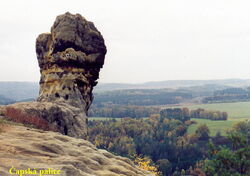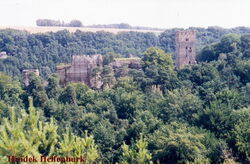Living in the shadow of the better-known Kokořínsko PLA (Protected Landscape Area) is the region covering the area between Dubá and Úštěk, a sylvan land abundant in rocks - whose frequent bizarre formations owe a great deal to its richness in iron oxides. Today’s starting point is Dubá, a market-town lying up from the northern border of the Mělník district, which became a recreational center during the onset of the cottage-dweller boom. You can get here from Mělník on one of the bus lines running from Prague to Rumburk or Jablonné v Podještědí. Follow the blue footpath starting at the bus station,  past a Baroque church from the mid-18th century, down the road a while and then on through the woods till you reach the peak of Dubová hora – but quit your worries, it only stands some 387m in elevation. Having climbed up, we can drop down again into the valley and from Pavličky on we will continue through this long valley down below Zámecké schody, a green footpath intersection. Those who haven’t taken the path to Peklo (Hell) at Čapská palice are most welcome to do so, as it is just at a stone’s throw, though you certainly will break some sweat while going up the stairs carved into rock.
past a Baroque church from the mid-18th century, down the road a while and then on through the woods till you reach the peak of Dubová hora – but quit your worries, it only stands some 387m in elevation. Having climbed up, we can drop down again into the valley and from Pavličky on we will continue through this long valley down below Zámecké schody, a green footpath intersection. Those who haven’t taken the path to Peklo (Hell) at Čapská palice are most welcome to do so, as it is just at a stone’s throw, though you certainly will break some sweat while going up the stairs carved into rock.
This time we shall continue along the green footpath, in the opposite direction from Čap, although not exactly to our benefit. It will not take long before we have the wood path winding up the Kostelecký crest. Make sure you don’t miss the turn leading to Krápník (Stalactite) and Tisící kámen (The Thousandth Stone), huge overhanging rocks, frequently providing hikers with shelter. And a little further the green footpath is joined from the right by a yellow one, coming from Martinská stěna - and those of you who don’t mind taking about a 1-km detour can follow it so as they could get a worthwhile view over the deep Komáří valley from the vista above. The two footpaths run some distance together but later we can bid the green one adieu at an intersection. The next dead-end path leads to Husa (Goose) – the crest path strewn with many observation points will take us to a sandstone rock-formation in the shape of a goose head, with two windows carved in it. Take the yellow footpath a little further and, on your right, you will get a view of Vlhošť, a phonolite mound standing 614 m above sea-level, surrounded by hulky sandstone terraces. From the Skalka settlement, a little below the top of Vlhošť, you can not only get a beautiful view over the České středohoří (the Czech highlands) but your eye will also rest on a stand where you can treat yourselves to a snack – even a pint won’t come amiss, since the next refreshment point can be found at the end of today’s trip in the wild. So drink up!
 Outside the village you have to walk down the road a little, but then the yellow footpath turns off and begins to slope down into the valley of Hrádecký potok (Hrádecký stream), where the red footpath joins up and both will take us to Helfenburk, a ruin of a castle from the 14th century. A bunch of enthusiasts are striving to renovate the ruin at the moment and so far they have been doing quite a good job, you can already access the tower. The admission fee intended for renovation, to be dropped into the moneybox, is optional. Following the tour of the ruin you can either take the shorter yellow footpath route leading through the valley, or the red footpath which will take you across the hill opposite the ruin where you can steal one last peek of the castle. The two footpaths meet again, but we shall take the yellow one and shortly after we come to Úštěk, our today’s journey’s destination. The conservation zone of buildings listed as cultural monuments offers sights such as the remains of the town fortifications, a chateau, a castle turned into a malt-house and brewery, Gothic and Renaissance houses, and a parsonage for a change in Baroque style. If the weather is fine, you can enjoy taking a dive in the large pond Chmelař, a very nice resort with two beaches and a sports center. Getting back home will only take a ride on the train to Litoměřice, where you need to get off at the upper station (horní Litoměřice) so you could enjoy walking through the city center, since all train connections running to Mělník or Všetaty – where you change to trains running to Prague – leave from the Litoměřice-město station. A final roundup - on today’s trip we have covered 25 kilometers altogether.
Outside the village you have to walk down the road a little, but then the yellow footpath turns off and begins to slope down into the valley of Hrádecký potok (Hrádecký stream), where the red footpath joins up and both will take us to Helfenburk, a ruin of a castle from the 14th century. A bunch of enthusiasts are striving to renovate the ruin at the moment and so far they have been doing quite a good job, you can already access the tower. The admission fee intended for renovation, to be dropped into the moneybox, is optional. Following the tour of the ruin you can either take the shorter yellow footpath route leading through the valley, or the red footpath which will take you across the hill opposite the ruin where you can steal one last peek of the castle. The two footpaths meet again, but we shall take the yellow one and shortly after we come to Úštěk, our today’s journey’s destination. The conservation zone of buildings listed as cultural monuments offers sights such as the remains of the town fortifications, a chateau, a castle turned into a malt-house and brewery, Gothic and Renaissance houses, and a parsonage for a change in Baroque style. If the weather is fine, you can enjoy taking a dive in the large pond Chmelař, a very nice resort with two beaches and a sports center. Getting back home will only take a ride on the train to Litoměřice, where you need to get off at the upper station (horní Litoměřice) so you could enjoy walking through the city center, since all train connections running to Mělník or Všetaty – where you change to trains running to Prague – leave from the Litoměřice-město station. A final roundup - on today’s trip we have covered 25 kilometers altogether.
